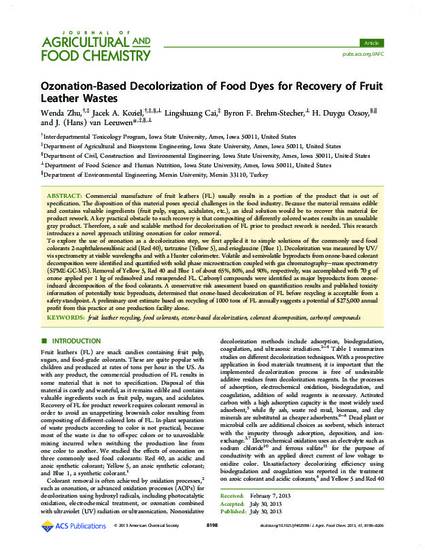
Commercial manufacture of fruit leathers (FL) usually results in a portion of the product that is out of specification. The disposition of this material poses special challenges in the food industry. Because the material remains edible and contains valuable ingredients (fruit pulp, sugars, acidulates, etc.), an ideal solution would be to recover this material for product rework. A key practical obstacle to such recovery is that compositing of differently colored wastes results in an unsalable gray product. Therefore, a safe and scalable method for decolorization of FL prior to product rework is needed. This research introduces a novel approach utilizing ozonation for color removal.
To explore the use of ozonation as a decolorization step, we first applied it to simple solutions of the commonly used food colorants 2-naphthalenesulfonic acid (Red 40), tartrazine (Yellow 5), and erioglaucine (Blue 1). Decolorization was measured by UV/vis spectrometry at visible wavelengths and with a Hunter colorimeter. Volatile and semivolatile byproducts from ozone-based colorant decomposition were identified and quantified with solid phase microextraction coupled with gas chromatography–mass spectrometry (SPME-GC-MS). Removal of Yellow 5, Red 40 and Blue 1 of about 65%, 80%, and 90%, respectively, was accomplished with 70 g of ozone applied per 1 kg of redissolved and resuspended FL. Carbonyl compounds were identified as major byproducts from ozone-induced decomposition of the food colorants. A conservative risk assessment based on quantification results and published toxicity information of potentially toxic byproducts, determined that ozone-based decolorization of FL before recycling is acceptable from a safety standpoint. A preliminary cost estimate based on recycling of 1000 tons of FL annually suggests a potential of $275,000 annual profit from this practice at one production facility alone.
Available at: http://works.bepress.com/jacek_koziel/93/

Reposted with permission from Journal of Agricultural and Food Chemistry 61 (2013): 8198–8206, doi:10.1021/jf402590t.Copyright 2013 American Chemical Society.